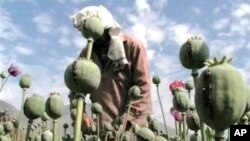The U.N. drug agency says Afghanistan's opium production declined by almost half this year. But it says that is mainly due to crop disease - overall cultivation levels remained the same.
The U.N. Afghanistan Opium Survey 2010 says the decline in production was caused by a plant disease that destroyed poppy fields, mostly in the major opium-producing regions Kandahar and Helmand.
The survey found the amount of land used for growing opium remained the same as last year.
The head of statistics at the U.N. Office on Drugs and Crimes, Angela Me, says that does not mean efforts to curb cultivation are failing.
She says policies such as handing out wheat seeds can make a difference - and in some parts of Afghanistan cultivation levels have gone down. "There are provinces where they had high cultivation last year where there was a major decrease so it looks like there something is working," she said.
Twenty provinces that were opium-free in the last survey remained so and another four provinces were almost poppy-free. Opium cultivation in Helmand dropped by seven percent.
But in other areas cultivation went up - in Kandahar by as much as 30 percent.
Most of Afghanistan's poppies are cultivated in the country's southern and western provinces - namely in Helmand and Kandahar, the heart of the Taliban insurgency.
"Where we see the increase is again the areas where there is a major issue of insecurity and so we can see that the cultivation is still linked to security and it is concentrated in the areas where the government has less access," Me said.
The Taliban is believed to get much of its funding from Afghanistan's opium production.
Me says although crop disease wiped out much of the opium plants, the profits may not have gone down.
Between 2005 and 2009, the value of opium was in decline. But in 2010 the average farm gate price of opium had risen by more than 150 percent compared to the 2009 price.
"Even if the production was reduced, the total farm gate value of the production increased," Me said, "It means that the money that goes to the insurgency increased."
Me says the increased price of opium may lead many farmers to start or restart cultivating the crop. Afghanistan produces about 90 percent of the world's opium, which is used to make heroin. Fifty percent of Afghanistan's opium crop is cultivated in Helmand.
Related video report by Robert Raffaele:






